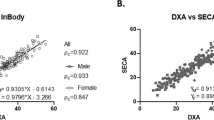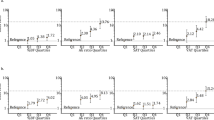Abstract
Background:
The sensitivity to detect small changes in body composition (fat mass and fat-free mass) largely depends on the precision of the instrument. We compared EchoMRI-AH and dual-energy X-ray absorptiometry (DXA) (Hologic QDR-4500A) for estimating fat mass in 301 volunteers.
Methods:
Body composition was evaluated in 136 males and 165 females with a large range of body mass index (BMI) (19−49 kg m−2) and age (19−91 years old) using DXA and EchoMRI-AH. In a subsample of 13 lean (BMI=19–25 kg m−2) and 21 overweight/obese (BMI>25 kg m−2) individuals, within-subject precision was evaluated from repeated measurements taken within 1 h (n=3) and 1 week apart (mean of three measurements taken on each day).
Results:
Using Bland–Altman analysis, we compared the mean of the fat mass measurements versus the difference in fat mass measured by both instruments. We found that EchoMRI-AH quantified larger amount of fat versus DXA in non-obese (BMI<30 kg m−2 (1.1 kg, 95% confidence interval (CI95):−3.7 to 6.0)) and obese (BMI⩾30 kg m−2 (4.2 kg, CI95:−1.4 to 9.8)) participants. Within-subject precision (coefficient of variation, %) in fat mass measured within 1 h was remarkably better when measured by EchoMRI-AH than DXA (<0.5 versus <1.5%, respectively; P<0.001). However, 1-week apart within-subject variability showed similar values for both instruments (<2.2%; P=0.15).
Conclusions:
EchoMRI-AH yielded greater fat mass values when compared with DXA (Hologic QDR-4500A), particularly in fatter subjects. EchoMRI-AH and DXA showed similar 1-week apart precision when fat mass was measured both in lean and overweight/obese individuals.
This is a preview of subscription content, access via your institution
Access options
Subscribe to this journal
Receive 12 print issues and online access
$259.00 per year
only $21.58 per issue
Buy this article
- Purchase on Springer Link
- Instant access to full article PDF
Prices may be subject to local taxes which are calculated during checkout





Similar content being viewed by others
References
Kopelman PG . Obesity as a medical problem. Nature 2000; 404: 635–643.
Cawthorne MA . Opportunities and challenges for the development of pharmacological therapies for obesity treatment. Obes Rev 2007; 8 (Suppl 1): 131–136.
Aronne LJ, Wadden T, Isoldi KK, Woodworth KA . When prevention fails: obesity treatment strategies. Am J Med 2009; 122 (4 Suppl 1): S24–S32.
Taicher GZ, Tinsley FC, Reiderman A, Heiman ML . Quantitative magnetic resonance (QMR) method for bone and whole-body-composition analysis. Anal Bioanal Chem 2003; 377: 990–1002.
Napolitano A, Miller SR, Murgatroyd PR, Coward WA, Wright A, Finer N et al. Validation of a quantitative magnetic resonance method for measuring human body composition. Obesity (Silver Spring) 2008; 16: 191–198.
Bland JM, Altman DG . Statistical methods for assessing agreement between two methods of clinical measurement. Lancet 1986; 1: 307–310.
Jebb SA . Measurement of soft tissue composition by dual energy X-ray absorptiometry. Br J Nutr 1997; 77: 151–163.
Plank LD . Dual-energy X-ray absorptiometry and body composition. Curr Opin Clin Nutr Metab Care 2005; 8: 305–309.
Pietrobelli A, Formica C, Wang Z, Heymsfield SB . Dual-energy X-ray absorptiometry body composition model: review of physical concepts. Am J Physiol 1996; 271 (6 Part 1): E941–E951.
Jebb SA, Goldberg GR, Jennings G, Elia M . Dual-energy X-ray absorptiometry measurements of body composition: effects of depth and tissue thickness, including comparisons with direct analysis. Clin Sci (Lond) 1995; 88: 319–324.
Schoeller DA, Tylavsky FA, Baer DJ, Chumlea WC, Earthman CP, Fuerst T et al. QDR 4500A dual-energy X-ray absorptiometer underestimates fat mass in comparison with criterion methods in adults. Am J Clin Nutr 2005; 81: 1018–1025.
Widjaja A, Morris RJ, Levy JC, Frayn KN, Manley SE, Turner RC . Within- and between-subject variation in commonly measured anthropometric and biochemical variables. Clin Chem 1999; 45: 561–566.
Acknowledgements
This work was funded by a CNRU P30 grant DK072476 (ER). JEG was supported by a fellowship from The International Nutrition Foundation/Ellison Medical Foundation.
Author information
Authors and Affiliations
Corresponding author
Ethics declarations
Competing interests
The authors declare no conflict of interest.
Rights and permissions
About this article
Cite this article
Galgani, J., Smith, S. & Ravussin, E. Assessment of EchoMRI-AH versus dual-energy X-ray absorptiometry to measure human body composition. Int J Obes 35, 1241–1246 (2011). https://doi.org/10.1038/ijo.2010.268
Received:
Revised:
Accepted:
Published:
Issue Date:
DOI: https://doi.org/10.1038/ijo.2010.268
Keywords
This article is cited by
-
Body Composition During Pregnancy: Longitudinal Changes and Method Comparisons
Reproductive Sciences (2020)
-
Assessment of EchoMRI-AH versus dual-energy X-ray absorptiometry by iDXA to measure human body composition
European Journal of Clinical Nutrition (2017)



